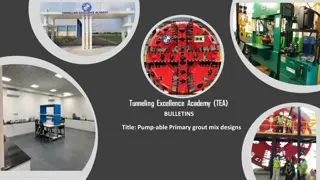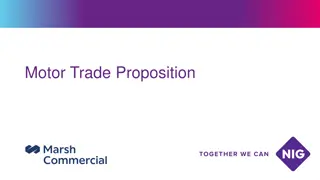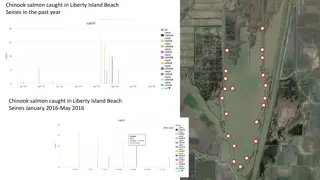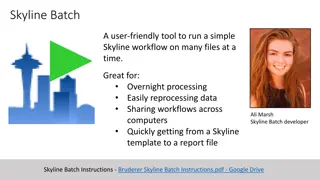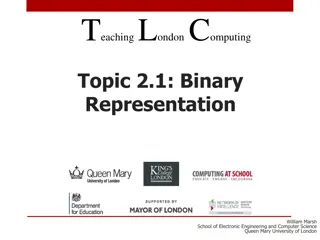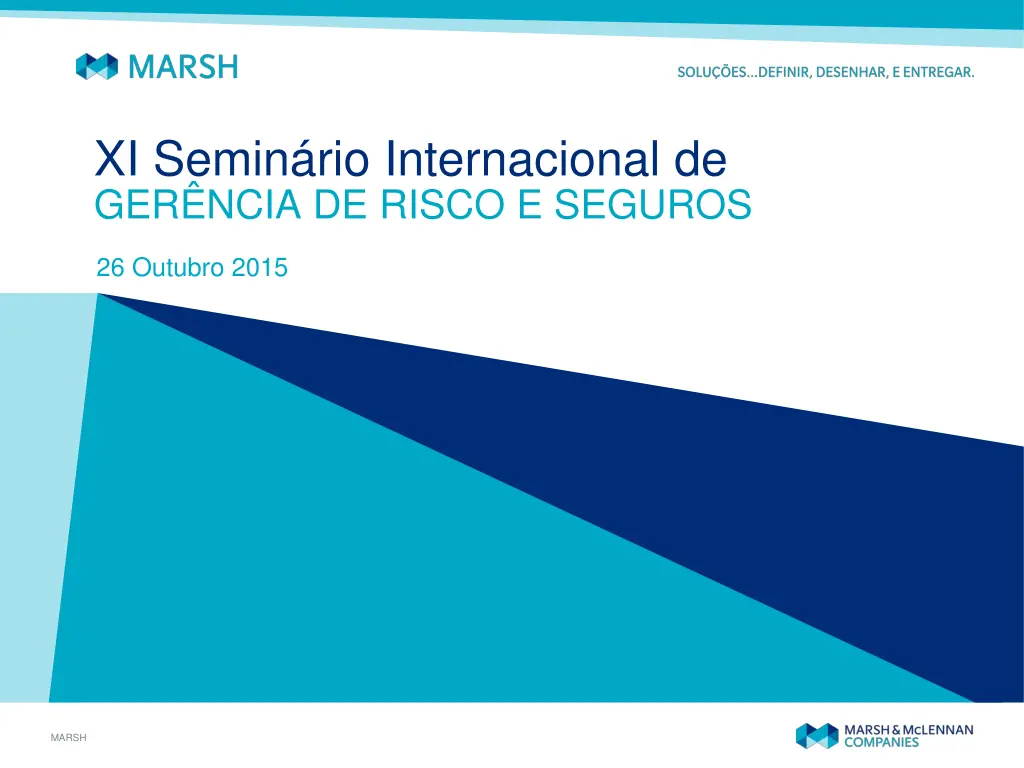
Multilatinas Risk Management Insights
Gain valuable insights into risk management strategies for multilatinas, including the importance of insurance, risk tolerance, capital sources, and leveraging data and analytics. Explore typical questions CFOs ask their risk managers and learn about the excellence in risk management survey results.
Download Presentation

Please find below an Image/Link to download the presentation.
The content on the website is provided AS IS for your information and personal use only. It may not be sold, licensed, or shared on other websites without obtaining consent from the author. If you encounter any issues during the download, it is possible that the publisher has removed the file from their server.
You are allowed to download the files provided on this website for personal or commercial use, subject to the condition that they are used lawfully. All files are the property of their respective owners.
The content on the website is provided AS IS for your information and personal use only. It may not be sold, licensed, or shared on other websites without obtaining consent from the author.
E N D
Presentation Transcript
XI Seminrio Internacional de GER NCIA DE RISCO E SEGUROS 26 Outubro 2015 MARSH
TYPICAL QUESTIONS CFOS FROM MULTILATINAS ARE ASKING TO THEIR RISK MANAGERS $ WHY WE BUY INSURANCE? Why we need to by global programs and for which lines? HOW MUCH RISK CAN MY COMPANY TOLERATE? What are our company s sources of capital and how do we prefer to deploy those resources to deal with unexpected losses? Do we understand how economic, legal, and fiscal trends impact my industry and affect long-and short-term risk strategies? MARSH
TYPICAL QUESTIONS CFOS FROM MULTILATINAS ARE ASKING TO THEIR RISK MANAGERS IS MY REGIONAL PROGRAM IS GETTING THE EXPECTED VALUE FROM ITS INSURANCE PURCHASE? IS MY COMPANY ADEQUATELY PROTECTED AGAINST RISK? Are my company s limits and deductibles appropriate? How my program is priced and how can I benefit from economies of scale (regional programs) Do my insurance structure reflect corporate risk tolerance? Cost of retaining risk vs. cost of transferring risk (premium)? Whose capital is cheaper: my company s or your insurance carrier s? MARSH
How some multilatinas are leveraging data and analytics to improve their risk management strategy and cost reduction efforts? EXCELLENCE IN RISK MANAGEMENT SURVEY 74% of the respondents said their organization need to make a deeper analysis of their risk-related data 79% of insurers are simulating internal risks to satisfy regulatory requirements. MARSH
$ WHY WE BUY INSURANCE? Comparison between casinos and insurance. Average return for every $1 spent MARSH
WHY WE BUY INSURANCE? $ Comparison between casinos and insurance. Average return for every $1 spent The amount of losses at any one company fluctuates unpredictably from year to year. In fact, this uncertainty is the main reason that companies buy insurance and create loss control and mitigation programs Claude Yoder and Dave Heppen, CFO Magazine MARSH
WHY WE BUY INSURANCE? Do we need to buy insurance and for which lines? Risks that similar companies are facing. Which are my signature risks? $ 10 9 8 7 6 Frequency 5 4 3 2 1 0 1 2 3 4 5 6 7 8 9 1 0 Severity MARSH
HOW MUCH RISK CAN MY COMPANY TOLERATE? What are your company s sources of capital and how do you prefer to deploy those resources to deal with unexpected losses? Arrives at an earnings miss that might cause a drop in share value Earnings Miss the equity holders view Estimates the volatility built into earnings estimates Typically discounts intangible assets Looks at earnings miss required for one or more notch rating downgrade(s) Debt Coverage The Bondholders View Emphasis on interest coverage Might look at other loan covenants KPIs are selected from: Balance sheet Income statement Access to other funds Key Performance Indicators (KPIs) Qualitative View Flexibility allows for reflection of company culture Appropriate for private companies MARSH
IS MY COMPANY ADEQUATELY PROTECTED AGAINST RISK? Are my company s limits and deductibles appropriate? Do my insurance structure reflect corporate risk tolerance? Uninsured Losses = WACC* Unexpected Losses Retained Loss Insured Loss Frequency Severity MARSH
IS MY COMPANY ADEQUATELY PROTECTED AGAINST RISK GLOBALLY? How my program is priced and how can I benefit from economies of scale (regional programs) Cost of retaining risk vs. cost of transferring risk (premium)? Whose capital is cheaper: my company s or your insurance carrier s? Retained After Insurance 3,780,731 13,111,817 3.40 (Cost) / Benefit 726,127 Before Insurance Key Statistics 5,506,858 23,875,866 5.30 Average Annual Losses Standard Deviation Coefficient of Variation 0 0 0 3,020,342 3,020,342 3,020,342 3,270,342 3,520,342 34,936,070 -3,020,342 -3,020,342 -3,020,342 -1,651,119 82,159,228 116,979,658 1 in 1.33 Years 25% Perc Insurance looks like only a cost when you don t have losses 1 in 2 Years 50% Perc 1 in 4 Years 75% Perc Insurance begins to pay off 1,619,223 85,679,570 151,915,728 1 in 10 Years 90% Perc 1 in 100 Years 99% Perc Substantial benefit, multiples of premium paid 1 in 250 Years 99.6% Perc ECONOMIC COST OF RISK (ECOR) NO INSURANCE 5,146,309 0 2,036,577 110,000 7,292,886 SIGN + + + + = COMPONENTS CURRENT PROGRAM 3,402,658 3,020,342 510,399 45,000 6,978,399 OPTION A 3,814,605 2,416,274 572,191 57,000 6,860,070 Option B 3,938,994 2,265,257 669,629 70,000 6,943,880 Discounted Average Retained Losses Premium Financial cost of unexpected losses Collateral and Other Admin Costs Economic Cost of Risk Optimized Program MARSH
IS MY COMPANY ADEQUATELY PROTECTED AGAINST RISK GLOBALLY? How my program is priced and how can I benefit from economies of scale (regional programs) Cost of retaining risk vs. cost of transferring risk (premium)? Whose capital is cheaper: my company s or your insurance carrier s? Carriers may no longer need to compete on price; they instead may be able to assess the risk of individual customers based on their actual behaviors Business Insurance MARSH
THE EVOLVING ROLE OF THE RISK MANAGER RISK MANAGEMENT Is a business discipline that protects assets, earning stream and profits of an organization by preventing potential losses before they occur, and executing a prompt recovery after losses occur Integrated/ Advanced Traditional/ Defensive ERM Silo ad hoc approach Business Risk Approach Portfolio approach Focus on transferring Risks Mitigate controllable risk Risk based business decisions across the organization Protect balance sheet though Prevent Address potential devastating threats and weaknesses Insurance Reduce frequency Hedging Reduce severity Exploit opportunities and strengths Indemnifications Focus on lowering insurance costs and retained losses Manage unwanted variations from expected outcomes Hazard Based Collaborative cross-silo interactions Not Linked to company strategy Integrated into strategic planning, operational planning and day to day activities Linked to corporate strategy through event risks and financial objectives Source: RIMS MARSH
XI Seminrio Internacional de GER NCIA DE RISCO E SEGUROS 26 Outubro 2015 MARSH



